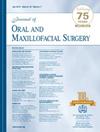Enhanced Recovery After Orthognathic Surgery: Evidence Synthesis for Postoperative Care
IF 2.6
3区 医学
Q2 DENTISTRY, ORAL SURGERY & MEDICINE
引用次数: 0
Abstract
Background
Enhanced recovery after surgery (ERAS) protocols have demonstrated substantial benefits across surgical specialties, including reduced hospital stays, decreased complications, and improved patient satisfaction. Despite growing interest in ERAS for orthognathic surgery, the optimal combination of postoperative elements remains undefined.
Purpose
This evidence synthesis identifies, evaluates, and synthesizes postoperative outcomes following orthognathic surgery that are improved by ERAS protocols.
Study Design, Setting, Sample
A systematic search of PubMed/MEDLINE, Cochrane Library, Embase, and Web of Science was conducted from inception through April 2025. Studies were included if they evaluated postoperative elements of ERAS protocols in orthognathic surgery with reported outcomes on length of stay, pain, opioid consumption, postoperative nausea and vomiting (PONV), or complications. Articles were screened by 2 independent reviewers following Preferred Reporting Items for Systematic Reviews and Meta-Analyses guidelines.
Results
Six studies (986 patients) met inclusion criteria. Evidence quality, assessed using Grading of Recommendations Assessment, Development, and Evaluation, was moderate for multimodal pain management and PONV prophylaxis but low to very low for mobilization, nutrition, and discharge planning. The strongest evidence supported scheduled nonopioid analgesics with limited opioids for breakthrough pain, which reduced maximum pain scores (5.50 ± 2.20 vs 7.50 ± 1.73, P < .001) and opioid consumption (9.38 ± 11.42 mg vs 51.44 ± 30.67 mg, P < .001). Risk-stratified multimodal PONV prophylaxis reduced PONV incidence (38.3 vs 63.2%, P = .005). Standardized discharge criteria facilitated same-day discharge (86.8 vs 20%, P < .01). Evidence for mobilization, nutrition management, and functional rehabilitation was limited and inconsistent.
Conclusions and Relevance
Implementation of ERAS protocols for orthognathic surgery was associated with improved pain control, lower opioid consumption, decreased PONV, and shorter length of stay. Scheduled nonopioid analgesics, limited use of opioids for breakthrough pain, and risk-stratified PONV prophylaxis showed the most consistent benefits. Future research should address knowledge gaps regarding early mobilization, nutrition management, and standardized discharge planning through well-designed prospective studies.
正颌手术后增强恢复:术后护理的证据综合。
背景:增强术后恢复(ERAS)方案已经证明在外科专科具有实质性的益处,包括缩短住院时间、减少并发症和提高患者满意度。尽管人们对正颌手术的ERAS越来越感兴趣,但术后因素的最佳组合仍未确定。目的:本证据综合鉴定、评估和综合ERAS方案改善的正颌手术术后结果。研究设计、设置、样本:系统检索PubMed/MEDLINE、Cochrane Library、Embase和Web of Science,从研究开始到2025年4月。如果研究评估了ERAS方案在正颌手术中的术后因素,并报告了住院时间、疼痛、阿片类药物消耗、术后恶心和呕吐(PONV)或并发症的结果,则纳入研究。文章由2名独立审稿人按照系统评价和荟萃分析指南的首选报告项目进行筛选。结果:6项研究(986例患者)符合纳入标准。采用建议评估、发展和评价分级法对证据质量进行评估,多模式疼痛管理和PONV预防的证据质量为中等,而动员、营养和出院计划的证据质量为低至极低。最有力的证据支持限制阿片类药物的非阿片类药物用于突破性疼痛,可降低最大疼痛评分(5.50±2.20 vs 7.50±1.73,P < 0.001)和阿片类药物消耗(9.38±11.42 mg vs 51.44±30.67 mg, P < 0.001)。风险分层的多模式PONV预防降低了PONV发病率(38.3 vs 63.2%, P = 0.005)。标准化出院标准促进当日出院(86.8 vs 20%, P < 0.01)。动员、营养管理和功能康复的证据有限且不一致。结论和相关性:在正颌手术中实施ERAS方案可改善疼痛控制、降低阿片类药物消耗、降低PONV和缩短住院时间。计划的非阿片类镇痛药,有限使用阿片类药物治疗突破性疼痛,以及风险分层PONV预防显示出最一致的益处。未来的研究应通过精心设计的前瞻性研究解决早期动员、营养管理和标准化出院计划方面的知识差距。
本文章由计算机程序翻译,如有差异,请以英文原文为准。
求助全文
约1分钟内获得全文
求助全文
来源期刊

Journal of Oral and Maxillofacial Surgery
医学-牙科与口腔外科
CiteScore
4.00
自引率
5.30%
发文量
0
审稿时长
41 days
期刊介绍:
This monthly journal offers comprehensive coverage of new techniques, important developments and innovative ideas in oral and maxillofacial surgery. Practice-applicable articles help develop the methods used to handle dentoalveolar surgery, facial injuries and deformities, TMJ disorders, oral cancer, jaw reconstruction, anesthesia and analgesia. The journal also includes specifics on new instruments and diagnostic equipment and modern therapeutic drugs and devices. Journal of Oral and Maxillofacial Surgery is recommended for first or priority subscription by the Dental Section of the Medical Library Association.
 求助内容:
求助内容: 应助结果提醒方式:
应助结果提醒方式:


